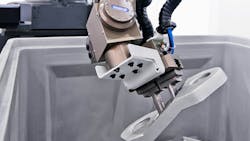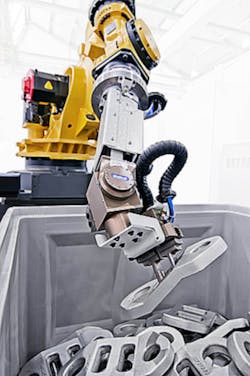Liebherr Automation will demonstrate a smart part-handling capability, one it explained effectively removes randomly placed items from a container and places them accurately in a machine or production line, using 3-D image recognition system software, a robot, and a sophisticated handling strategy.
This intelligent removal of items, such as the automated picking of unsorted components, is referred to as random bin-picking. Specially developed grippers with additional axes enable collision-free access and the removal of items from the container, and subsequently allows for precise positioning of the item into a fixture or pallet.
The Liebherr custom bin-picking technology, designed for components weighing 1-50 kilograms, creates the potential for productivity and efficiency improvements while processing a range of parts, including heavy and/or delicate parts for automotive, aerospace, general machining, and commercial vehicles.
The advantages of the scalable random bin-picking process include increased productivity, improved machine utilization rates, reduced need for additional machines to achieve desired plant production volumes, and more consistent production quality.
The developer has experience with other “process-reliable solutions” that achieve the cycle times and high availability rates manufacturers require -- including complete systems for automotive operations, among other industrial sectors. These include the efficient channeling of non-rotationally symmetrical components that arrive randomly in a bin and can be placed into production lines and hardening ovens. The beginning of a production line is the critical point where picking from the bin is necessary.
An important step in development of random bin-picking process occurred with the object-recognition system, with a 3D laser scanner that accurately identifies the components to be collected. Outside light of any type in the production building has zero effect on the ability to pick a part: It will even recognize black, brown ,and rusty parts.
The accompanying software segments identify and select information about items and constraints in the bin.
About the Author
Robert Brooks
Content Director
Robert Brooks has been a business-to-business reporter, writer, editor, and columnist for more than 20 years, specializing in the primary metal and basic manufacturing industries.

